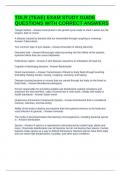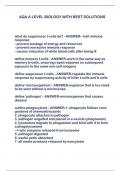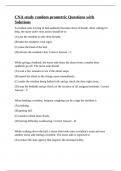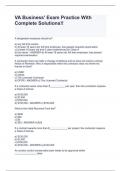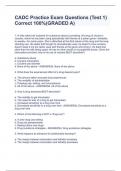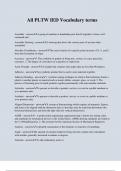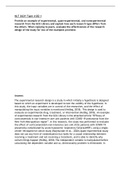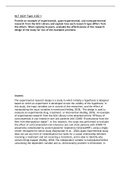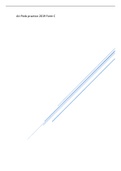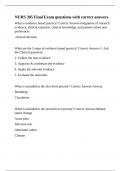TDLR (TEAE) EXAM STUDY GUIDE
QUESTIONS WITH CORRECT ANSWERS
Telegen lashes - Answer-Final phase in the growth cycle ready to shed. Lashes are the
longest, dark & course.
A disease caused by bacteria that are transmitted through coughing or sneezing -
Answer-Tuberculosis
Two common type of eye shapes - Answer-Rounded or oblong (almond)
Demodex mite - Answer-Microscopic mites burrowing into the follicle of the eyelash,
eyebrow follicle that can cause blepharitis.
Pediculosis capitis - Answer-A skin disease caused by an infestation of head lice
Capable of destroying bacteria - Answer-Bactericidal
Direct transmission - Answer-Transmission of blood or body fluids through touching
(including shaking hands), kissing, coughing, sneezing, and talking.
Disease-causing bacteria or viruses that are carried through the body on the blood or
body fluids - Answer-Bloodborne pathogens
Person responsible for providing suitable wet disinfectant soaking containers and
autoclave dry heat sterilizer, copy of current law & rules book, comply with safety &
health standards - Answer-Salon owner
Quaternary Ammonium Compounds (Quats) - Answer-Disinfectant that is considered
nontoxic, odorless, and fast-acting
Ability of the body to destroy any bacteria that have gained entrance to the body and
resist infection in general. - Answer-Immunity
The mode of decontamination that destroys microorganisms, including bacterial spores
is - Answer-Sterilization
Spores - Answer-A spore is a reproductive cell produced by certain fungi, plants and
moss. Chemicals disinfectants can kill bacteria, but do not destroy their spores. Certain
bacteria make spores as a way to defend themselves. Bacteria spores have thick walls
and can resist high temperatures, humidity, and other poor conditions.
, A process called sterilization destroys spores and bacteria. It is done at high
temperatures and under high pressures. In health-care settings, sterilization is usually
done using a device called an autoclave.
Sanitize - Answer-The process of destroying or reducing organisms on a clean surface
to a safe level.
70% - Answer-Isopropyl Alcohol Concentration
Carbolic acid; caustic poison; in 5% dilute solution is used to sanitize metallic
implements - Answer-Phenol
90% - Answer-Ethyl Alcohol Concentration
Eyelash growth cycle - Answer-a cycle lasting approx. 30 to 60 days that includes
growth cycles (anagen-growth, catagen-rest, telogen-shedding)
State Regulatory Agencies - Answer-A set guidelines for the manufacturing, sale and
use of equipment and chemical, and along safety standards in the workplace.
Evaluation - Answer-A comprehensive process of obtaining and interpreting the data
necessary to understand the individual, system, or situation
Slender, hair-like extensions that permit locomotion in certain bacteria ; whip-like motion
moves them in liquid - Answer-Cilia
Causing disease; harmful - Answer-Pathogenic disease
Asymptomatic - Answer-Showing no symptoms or signs of infection
Infectious - Answer-Communicable by infection, as from one person to another or from
one part of the body to another
Short, rod-shaped bacteria; the most common bacteria; produce diseases such as
tetanus (lockjaw), typhoid fever, tuberculosis, and diphtheria - Answer-Bacilli (Singular;
Bacillus)
Also known as barber's itch; a superficial fungal infection that commonly affects the
skin. It is primarily to the beared areas of thee face and neck or around the scalp -
Answer-Tine barbae
Cocci - Answer-Round shaped bacteria that appear singly or in groups (3 types
staphylococci, streptococci, and diplococci)
Conditions of some part of the body as protective response to injury, irritation, or
infection, characterized by redness, heat pain, and swelling - Answer-Inflammation
QUESTIONS WITH CORRECT ANSWERS
Telegen lashes - Answer-Final phase in the growth cycle ready to shed. Lashes are the
longest, dark & course.
A disease caused by bacteria that are transmitted through coughing or sneezing -
Answer-Tuberculosis
Two common type of eye shapes - Answer-Rounded or oblong (almond)
Demodex mite - Answer-Microscopic mites burrowing into the follicle of the eyelash,
eyebrow follicle that can cause blepharitis.
Pediculosis capitis - Answer-A skin disease caused by an infestation of head lice
Capable of destroying bacteria - Answer-Bactericidal
Direct transmission - Answer-Transmission of blood or body fluids through touching
(including shaking hands), kissing, coughing, sneezing, and talking.
Disease-causing bacteria or viruses that are carried through the body on the blood or
body fluids - Answer-Bloodborne pathogens
Person responsible for providing suitable wet disinfectant soaking containers and
autoclave dry heat sterilizer, copy of current law & rules book, comply with safety &
health standards - Answer-Salon owner
Quaternary Ammonium Compounds (Quats) - Answer-Disinfectant that is considered
nontoxic, odorless, and fast-acting
Ability of the body to destroy any bacteria that have gained entrance to the body and
resist infection in general. - Answer-Immunity
The mode of decontamination that destroys microorganisms, including bacterial spores
is - Answer-Sterilization
Spores - Answer-A spore is a reproductive cell produced by certain fungi, plants and
moss. Chemicals disinfectants can kill bacteria, but do not destroy their spores. Certain
bacteria make spores as a way to defend themselves. Bacteria spores have thick walls
and can resist high temperatures, humidity, and other poor conditions.
, A process called sterilization destroys spores and bacteria. It is done at high
temperatures and under high pressures. In health-care settings, sterilization is usually
done using a device called an autoclave.
Sanitize - Answer-The process of destroying or reducing organisms on a clean surface
to a safe level.
70% - Answer-Isopropyl Alcohol Concentration
Carbolic acid; caustic poison; in 5% dilute solution is used to sanitize metallic
implements - Answer-Phenol
90% - Answer-Ethyl Alcohol Concentration
Eyelash growth cycle - Answer-a cycle lasting approx. 30 to 60 days that includes
growth cycles (anagen-growth, catagen-rest, telogen-shedding)
State Regulatory Agencies - Answer-A set guidelines for the manufacturing, sale and
use of equipment and chemical, and along safety standards in the workplace.
Evaluation - Answer-A comprehensive process of obtaining and interpreting the data
necessary to understand the individual, system, or situation
Slender, hair-like extensions that permit locomotion in certain bacteria ; whip-like motion
moves them in liquid - Answer-Cilia
Causing disease; harmful - Answer-Pathogenic disease
Asymptomatic - Answer-Showing no symptoms or signs of infection
Infectious - Answer-Communicable by infection, as from one person to another or from
one part of the body to another
Short, rod-shaped bacteria; the most common bacteria; produce diseases such as
tetanus (lockjaw), typhoid fever, tuberculosis, and diphtheria - Answer-Bacilli (Singular;
Bacillus)
Also known as barber's itch; a superficial fungal infection that commonly affects the
skin. It is primarily to the beared areas of thee face and neck or around the scalp -
Answer-Tine barbae
Cocci - Answer-Round shaped bacteria that appear singly or in groups (3 types
staphylococci, streptococci, and diplococci)
Conditions of some part of the body as protective response to injury, irritation, or
infection, characterized by redness, heat pain, and swelling - Answer-Inflammation

